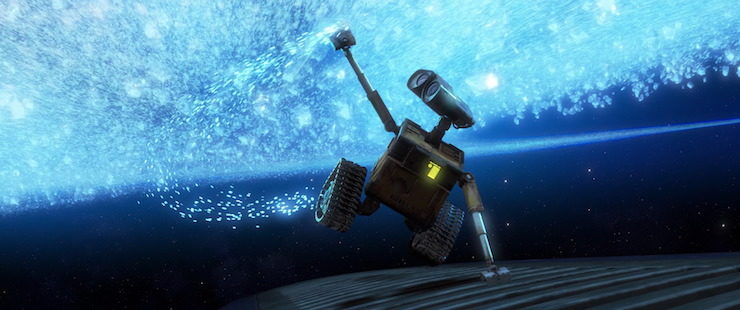Now that Disney and Pixar were finally, firmly united under one corporate umbrella, Pixar animators surprised everyone by doing something a bit different: creating a film that Disney could not use to sell toys.
Instead, their new film, WALL-E, would explicitly call out the culture of overconsumption that Disney so avidly promoted, making it one of the most anti-Disney products ever to be released by Walt Disney Studios Motion Pictures—an interesting start to the new Disney/Pixar relationship.
It’s tempting to wonder what WALL-E might have been like had it gone into development back in the 1990s—especially since that could have happened. The idea of a robot film was first pitched shortly before the release of Toy Story, well before anyone had any clue just how much money could and would be made from merchandise, and especially toys, based on Pixar films. It’s not entirely a coincidence that, while still unaware of that potential, Disney and Pixar put the toy-unfriendly A Bug’s Life into production, and definitely not a coincidence that once aware of that potential, Pixar’s next two films, Monsters, Inc. and Finding Nemo, featured characters that could easily be turned into soft, huggable toys. Had Pixar chosen to create WALL-E instead of A Bug’s Life—well, we probably would have gotten a cute robot film. Had Pixar chosen to create WALL-E instead of the other two films—well, it’s a safe bet that we would have been drowning in cute robot toys.
In any case, by the time WALL-E was ready for production in 2003, Pixar animators were well aware of the toy potential—but also aware that the previous Pixar films, with the arguable exceptions of A Bug’s Life and Cars, had gained attention not just as major money makers, but as art. They were also aware—or thought they were aware—that their relationship with Disney was coming to an end. They could, they thought, focus on art, and not toys or potential toys.
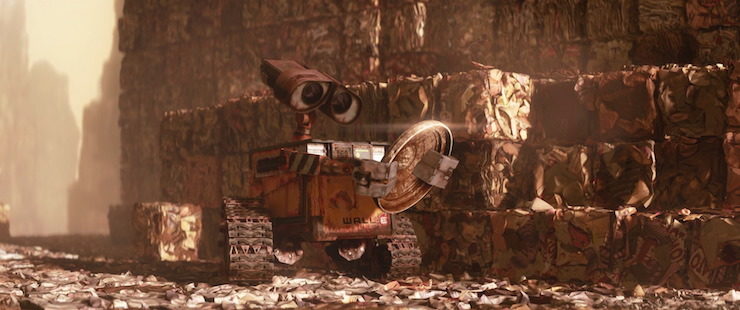
So instead, Pixar decided to try to do something else, something that had not been seen in Western film animation for years—lengthy animated sequences without a single word of dialogue. This, too, was almost expressly against Disney, which had more or less become an industry juggernaut by adding sound and dialogue to animation, and—Fantasia films and a few shorts aside—had continued to keep dialogue in their films. Pixar also decided to add something that had not been done anywhere in Western animation, and only rarely in live action Hollywood films: characters voiced solely by sound effects or computer programs. And by voicing, Pixar meant actual words created through those sound effects and computer programs, would speak actual words.
That was a huge change. Ever since the 1927 The Jazz Singer, Hollywood films had tried to have all characters, whether live action or animated, voiced by living creatures—that is, humans, or when necessary and possible, animals. The unwritten rule had been bent by a few science fiction films, notably Star Wars and its sequels—but even Star Wars had turned to human voices to make human words. R2-D2 chirps and beeps but never says “LUKE. I AM YOUR ROBOT.” (Well. So far. I make no predictions about The Last Jedi. But I digress.) WALL-E would focus on machines, and, for the first time, credit a sound engineer as the voice of the character.
The sound engineer in question, Ben Burtt, had just finished work on Star Wars: Revenge of the Sith, and was not exactly enthusiastic about the idea of creating sounds for more robots. In fact, as he later admitted, the Revenge of the Sith experience had rather turned him off robots completely. The feeling did not last long. Not only would Burtt eventually return for The Force Awakens and The Last Jedi and several other non-Star Wars films as a main sound engineer at Skywalker Sound, but he was also intrigued enough by the idea of voicing robot words through sound effects that he agreed to join Pixar’s team, working alongside the animators to develop the character and voice of little WALL-E in what was rapidly becoming an ever more ambitious film.
For other robot characters, Pixar chose to use the Macintosh text to voice program, MacInTalk. It was a nice nod to Steve Jobs, who still owned 50.1% of Pixar when WALL-E was put into development in 2003. In another nice nod, Pixar asked Apple executive Jonathan Ive, who had helped design the iMac, iPod and (later) the iPhone, for input on EVE, and allowed WALL-E to find one remaining working iPod allowing him to watch Hello, Dolly! So if you were thinking, huh, Eve’s smooth shiny white curves do look vaguely like an early iPod, well, yes.
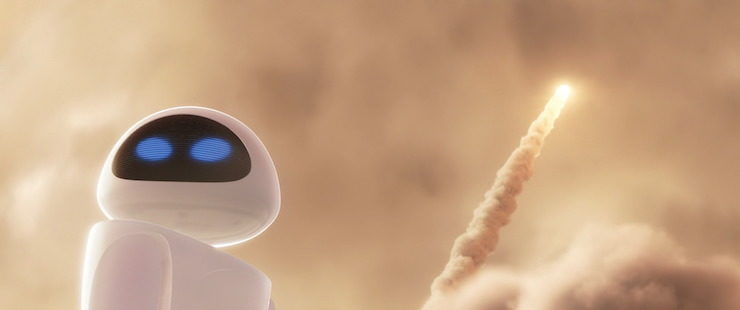
The film’s few human characters were voiced by comedians Jeff Garlin (who would later go on to ABC’s The Goldbergs) and Kathy Najimy (who would later voice the Evil Queen in Disney’s The Descendants), and Pixar stalwart John Ratzenberger. Sigourney Weaver provided additional computer voices. Fred Willard, renowned for his ability to play genial yet sleazy characters, was hired for what would be a Pixar first: live action footage inserted into the animated film. If using sound effects instead of voices was a revolt against the Disney tradition, this was a homage, in a sense, to some of Walt Disney’s earliest work in animation, the silent Alice comedies, which had attempted, not always successfully, to blend animation with live action—a technique the company would not truly master until decades after Walt Disney’s death, with Who Framed Roger Rabbit? Pixar had not mastered the technique either. For those parts of the film, they hired Industrial Light & Magic, who also helped to insert Hello, Dolly! clips into the film.
For all the technical innovation in the film, director and co-writer Andrew Stanton wanted more than something that just showcased revolutionary sound effects or Industrial Light & Magic’s digital and special effects. He wanted to tell a story. Specifically, the story of the last robot left on earth, surrounded by garbage, who finally—finally—finds a little green plant. And, well, a cockroach that the robot feeds with Twinkies, in a nod to the urban myth that no matter what happens to us or the planet, cockroaches and Twinkies will survive. Let us move past this unpleasant thought and back into the story development. Stanton had the mental images of the deserted, wasted, dusty planet, filled with collapsing buildings and trash and dust, with the occasional electronic sputter here and there, showing Fred Willard urging everyone—that is, every human, not every robot or cockroach—to flee Earth on a comfortable liner.
What Stanton didn’t have, at least at first, was anything beyond this. Brainstorming gave him the idea for a rather complicated plot featuring “aliens” who had sent EVE as an advanced robot probe; the twist was that the “aliens” would turn out to be humans, atrophied from years of living in space. Quite apart from the issue that a similar plot had been done before, Stanton could never work out the details, and ended up abandoning most of that plot, instead creating a caper film of EVE and WALL-E trying to deliver a plant to humans on a distant spaceship—humans who have nearly forgotten their origins and everything about earth, encased as they are on floating chairs, with very limited exercise, as robots attend to their every need.
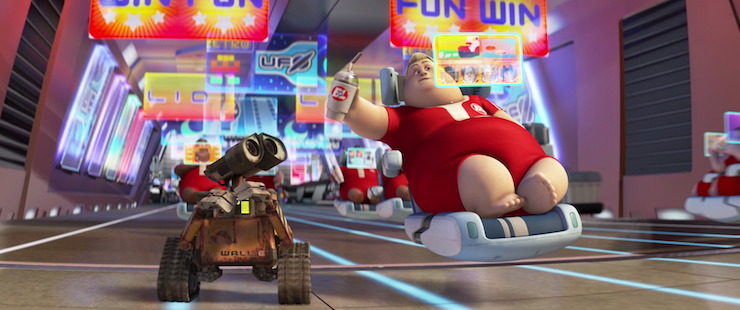
That perhaps helps explain why, to a certain extent, WALL-E almost feels like two films: a poignant fable of apocalypse, loneliness and love, told largely without words, and a tacked on silly caper film. It largely works, because by the time the film reaches the Axiom—the ship holding the remaining humans—WALL-E has already earned the emotional investment of audience members. Indeed, the little robot is arguably one of the most instantly sympathetic of the Pixar protagonists (Remy the rat runs a close second)—adorable, conscientious, lonely, more than a bit of a clown, desperate for friends, and caught on an unexpected journey to space.
I say largely, because the second half of the film is also considerably weaker than its first half, and not just because it portrays an even nastier, scornful view of the human race—after a first half that was not exactly kind in its portrayal of humans. Indeed, in initial screenings, audiences had problems believing that these humans would be able to survive again back on earth, thus some hasty and frankly not all that convincing bits added to the credits, to try to convince viewers that really, humans weren’t all that bad and incompetent no matter what the actual film had just said.
No, it’s mostly that the first half of the film is a virtual masterpiece in concise worldbuilding and storytelling, as well as a masterclass in film angles and computer animation, with robots falling in love. (Ok, well, one robot falling into unrequited love. At least at first.) Mostly filmed with bleached out whites and overexposed light—both to give the world a vast look, despite its claustrophobic towers of neatly squared away trash, and to save money, WALL-E creates a world of dust, ruin and trash in just a few minutes, along with its little robot protagonist. To recreate the look of the 70 mm film used for classic science fiction films, particularly 2001: A Space Odyssey, Stanton went to the effort to bring in old Panavision cameras, film a mockup of WALL-E’s world in 70 mm, and then copy that on the computer. The final result included several effects previously seen only on handheld cameras (and, if we are being fair, in some more cheaply made science fiction films that used the more standard 35 mm film), giving WALL-E a more realistic look.
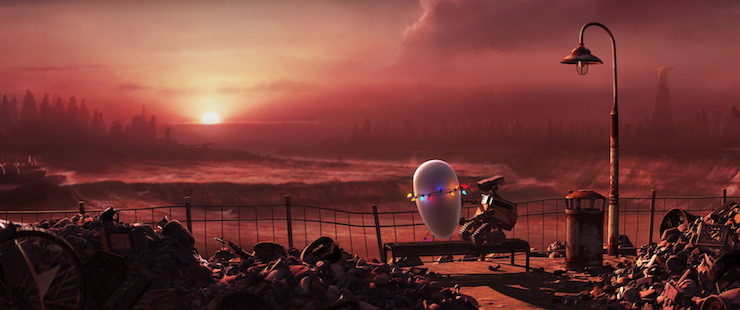
The second half of the film can’t really compete with this, and barely even tries. The tightness of the Axiom ship and the spaces within it meant that Stanton had little need for tricks such as keeping the backgrounds less focused than the foregrounds, giving WALL-E the look of “real film”—a trick that the classic hand-drawn and painted Disney films had sorta managed by simply painting slightly fuzzy backgrounds in some shots, but which for Pixar meant lots of experimenting with lighting, rendering and camera angles. The second half of the film needed considerably less of this, though Pixar did still throw in some effects shots with the never ending ads and occasional footage of an increasingly beset Fred Willard.
But that does not quite make the film look like Blade Runner, either, or any other “real film,” for that matter, apart from the moment when both WALL-E and EVE are blasted out into space. Instead, the second half the film—and particularly that moment—is pure cartoon.
It’s not bad, mind you—even by the now high Pixar standards. It has moments of high suspense—mostly that space blast—and bits of humor and more robots, including one bent on cleaning no matter what happens, and finding its life increasing frustrating. It’s just not as astonishing as the first half. I don’t think it helps that the second half borrows—deliberately—from 2001: A Space Odyssey, which makes certain twists just a little less surprising. Or that it contains some—well, let’s not call them plot holes, exactly, but sudden switches in robot characterization that seem put there more for plot than for common sense.
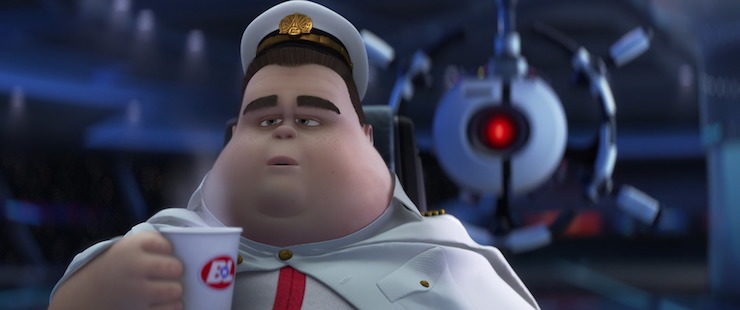
Or that, watching it, once again I found myself more than a little uneasy. Oh, not about the robots. I love the robots. Even the evil robot. A robot that loves Hello, Dolly!, a robot who prefers to shoot first, analyze later, and even a robot bound and determined to stay in space, no matter how evil that determination gets, will always gain my approval. No, my uneasiness stems from the depiction of the humans—and some major questions that I have about the end of the film, including, but not limited to, very pointed questions about oxygen.
Let’s get at least one of those questions out of the way: how is anyone breathing when they get off the ship? Sure, that cockroach is doing fine, but, that’s a cockroach. We’ve already established that it can survive anything. And sure, some bacteria are presumably around, including some oxygen producers, but still—it’s been only 800 years. Enough to turn the air from toxic to breathable? Given what we see of the planet, I find myself skeptical. Even with the presence of one tiny plant. Though, you go, seed, managing to spout after being dormant for so long. You go. It’s a very hopeful and inspiring plot line for many of us.
On a related note, I do find myself agreeing with viewers who have questioned just how long the Axiom survivors could last on the planet. Not, I hasten to add, because of their physical condition, but more because, given that they know little to nothing about Earth, I have to assume that they also know little to nothing about farming, which does not bode well for their attempts to transform a planet—particularly a planet still covered in garbage. Granted, the Axiom presumably has plants somewhere—the air quality on the spaceship seems fine, and everyone is eating, so presumably a few robots can offer some gardening tips. Still, spaceship farming is probably not all that similar to toxic soil gardening, so I remain skeptical.
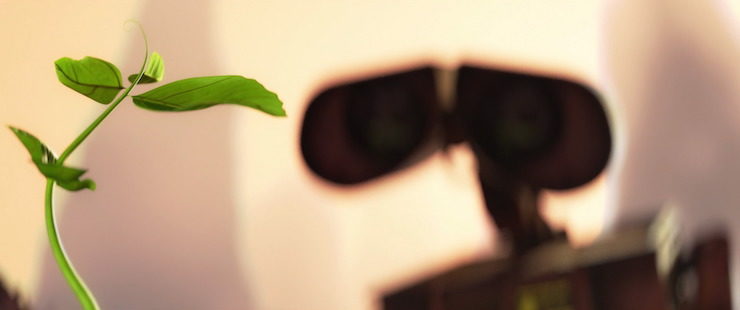
Another problem: the film shows the Axiom releasing several tons of trash, a process so routine I think we’re meant to believe that it happens regularly. That’s one thing for something like the Death Star, which appears to be receiving regular visits from Star Destroyers and other ships, at least some of which are presumably crating in new supplies, which in turn will create garbage that the Death Star needs to throw out in between blowing up planets. But it’s another thing for the Axiom, which is, from all appearances, not getting any new supplies from anywhere at all—no incoming ships, no stops on distant planets. Just starlight, and maybe some occasional space dust or an asteroid to mine. But given the amount of trash the Axiom tosses out, I find it difficult to believe that the ship isn’t slowly running out of supplies, which in turn leads to two more questions: why did the Axiom’s original owners program the autopilot to never return to Earth, given that they will need supplies again at some point, and nothing is said about visiting other planets, and two, what, exactly, are all of these people eating?
I also kinda have to ask why, given that the autopilot system was so adamant about not returning to the Earth, the Axiom continued to send robots back to Earth anyway. A second directive that the autopilot was not able to turn off, despite its ability to turn other systems on the spaceship off and on, should have allowed the autopilot to stop sending robots back to Earth.
And although I can fully understand why this was not brought up, let alone explained, I also have to wonder: if two humans find just touching hands to be a brand new experience, where did all those babies come from? Were the spaceship inhabitants all automatically sterilized, and new babies grown up in little test tubes or incubators?
And, well, on this viewing I couldn’t help noticing that the Axiom is not all that big—offering considerably less space than many major cities, and certainly not enough to provide for the entire world population. This suggests that even the “economy” class suggested by the ship (a class that is certainly filled with considerable luxury) was restricted to those with a lot of money. Like Steve Jobs levels of money. Well, maybe not that much, but still high—the ship could probably only hold a few thousand people, all of whom we see in a later clip coming out of the ship. Which in turn suggests that these are the very elites, who fled as the rest of the planet is dying.
On the other hand, their descendants are going to have to try to learn how to farm under the steady gaze of a cockroach. It evens out, I guess.
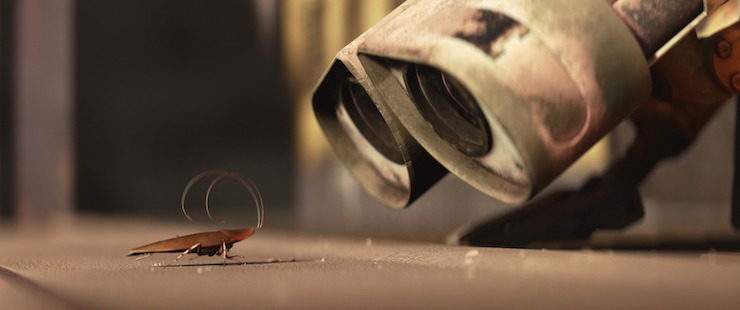
What doesn’t even out: the floating chairs.
It’s not just that the depiction of the humans on the Axiom perpetuates the stereotype that overweight people are overweight thanks to not exercising or laziness or both—especially since in this particularly case, something else seems to be going on here. Namely, that the autopilot, aware that it can’t allow humans to return to Earth, has instructed the robots on the ship to keep humans distracted and in their chairs at all time. The robots start showing videos to infants still in floating cribs; they try to prevent the captain from doing any physical activity on his own; and when two humans finally try to enter the pool without the chairs and splash around, the robots try to get them to stop. This is in direct contrast to the earlier Fred Willard sections, which promised that the Axiom would provide plenty of opportunities for physical exercise. So I don’t think the humans can exactly be blamed for failing to exercise here—they’re brainwashed not to.
But that in turn makes me uneasy for another reason: the film suggests that these floating chairs aren’t just making humans overweight and clumsy, but also ignorant and trapped. Which is to say, they are depicted as restrictive devices actively harming and trapping their users—
—when what they are, of course, are wheelchairs. Floating wheelchairs that offer considerably more entertainment possibilities than mine does, but, still. Wheelchairs.
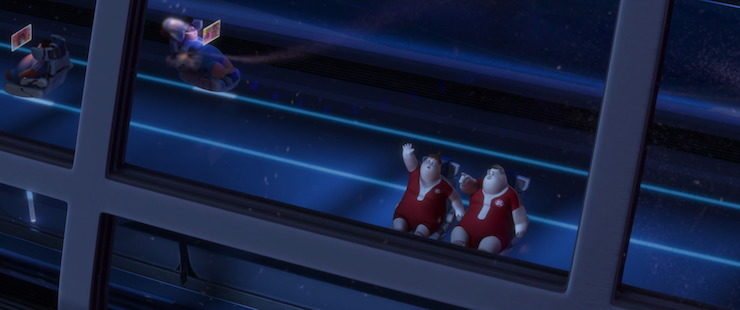
It’s yet another Hollywood depiction showing wheelchairs as restrictive devices, limiting their users, rather than what they generally are for users: tools allowing these users greater freedom and mobility.
So although I can completely buy the first half of the film, and completely buy this romance between two robots supposedly incapable of romance, I can’t buy the film’s ending. Making the wordless first half of this film must see viewing, the robot romance well worth viewing, and the rest—well. The rest still has those adorable robots.
The adorable robots were enough to make most critics and audience members love the film. WALL-E earned a solid $533.3 million at the box office, despite never getting aired in one of the world’s largest markets, China. WALL-E was nominated for six Academy Awards, winning for Best Animated Picture, as well as the Golden Globe for Best Animated Feature, the 2009 Hugo Award for Best Dramatic Presentation, the 2009 Nebula Award for Best Script, and various other awards, as well as appearing on multiple Top Lists in 2008.
Pixar was safely under full Disney ownership by the time WALL-E arrived on screen (a shift acknowledged within the film with a Hidden Mickey), but for once, Disney did not release the usual merchandise—in the minds of most manufacturers, WALL-E simply didn’t have the same toy potential as Cars, and WALL-E also offered fewer possibilities for stuffed toys. Not to mention the slight issue that the entire film acts as a critique of overconsumption and, well, Disney’s typical merchandising effort. Still, a few T-shirts and mugs were created, along with various Disney Trading Pins. As of now, the Disney Parks have not tried to create a WALL-E ride, but that could always change.
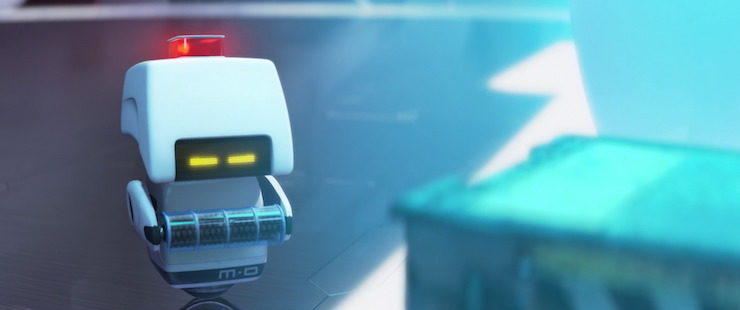
Meanwhile, having conquered both wordless storytelling and characters voiced by engineering and computers, not humans, Pixar thought it was time to move to a new challenge: a children’s film featuring a crotchety old man.
Up, coming up—forgive the pun—next month.
Mari Ness lives in central Florida.










